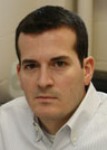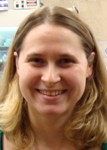Org. Synth. 2011, 88, 33-41
DOI: 10.15227/orgsyn.088.0033
THE PREPARATION OF INDAZOLES VIA METAL FREE INTRAMOLECULAR ELECTROPHILIC AMINATION OF 2-AMINOPHENYL KETOXIMES
Submitted by Carla M. Counceller, Chad C. Eichman, Brenda C. Wray, Eric R. Welin, and James P. Stambuli
1
.
Checked by John L. Tucker and Margaret Faul.
1. Procedure
A.
(E)-1-(2-Aminophenyl)ethanone oxime
(
1
). A 250-mL, three-necked round-bottomed flask equipped with a Teflon-coated 3.2-cm egg-shaped magnetic stir bar, internal temperature probe and a reflux condenser with nitrogen inlet is charged with distilled water (17.0 mL) and
ethanol (93.0 mL) (Notes 1, 2).
2'-Aminoacetophenone (9.00 mL, 10.0 g, 72.8 mmol, 1.00 equiv)
(Note 3) is added via syringe, and the solution is stirred during the addition.
Hydroxylamine hydrochloride (15.4 g, 223 mmol, 2.97 equiv)
(Note 4) is added in one portion, followed by
sodium hydroxide (23.7 g, 594 mmol, 8.16 equiv) (Notes 5 and 6). The reaction flask, which contains the resulting suspension of a white solid in a yellow liquid, is placed in an oil bath, and the internal temperature is held at 60 °C. After 1 h, TLC analysis (Note 7) revealed that the reaction is complete. The reaction flask is removed from the oil bath, and the white slurry is allowed to cool to ambient temperature. The mixture is transferred to a 1-L, single-necked round-bottomed flask (Note 8) and concentrated by rotary evaporation (bath temperature increased from 28 to 46 °C, 30-60 mmHg). The solid residue is dissolved in distilled water (140 mL). The aqueous solution is transferred to a 250-mL separatory funnel and is extracted three times with
ethyl acetate (3 × 100 mL)
(Note 9). The combined organic layers are dried over
MgSO4
(6.00 g). The drying agent is removed by filtration before the organic layer is concentrated by rotary evaporation (the bath temperature is increased from 30 to 45 °C, 30-60 mmHg) yielding the crude product as a white solid. This solid is dissolved in
dichloromethane (120 mL) (Notes 10, 1110, 11) at 25 °C, before
hexanes (20.0 mL)
(Note 12) is added over two min. Upon clouding, the solution is cooled in an ice/water bath to 0-5 °C, and
hexanes (100.0 mL) is added over 10 minutes. Crystals are allowed to age for 1 h at 0-5 °C, before isolation on a Büchner funnel. The white cotton-like solid is washed with ambient temperature
hexanes (30.0 mL). The mother liquor and wash are concentrated by rotary evaporation (bath temperature increased from 28 to 46 °C, 30-60 mmHg), yielding an off-white solid that is purified via crystallization using
dichloromethane (30 mL) and
hexanes (30 mL)
(Note 13). The first crop provided 7.50 g, and the second crop 0.91 g of product. The total yield of
(E)-1-(2-aminophenyl)ethanone oxime is
8.41 g (56.0 mmol, 76.9%, 98.0% pure by GC) (Notes 14, 15).
B.
3-Methyl-1H-indazole
(
2
). A 2-L single-necked round-bottomed flask equipped with a Teflon-coated 4-cm egg-shaped magnetic stir bar, a rubber septum, and nitrogen inlet is charged with
1-(2-aminophenyl) ethanone oxime (9.76 g, 65.0 mmol, 1.00 equiv) and
dichloromethane (1 L
) (Note 16).
Triethylamine (18.1 mL, 130 mmol, 2.00 equiv)
(Note 17) is added via syringe, and the reaction mixture is stirred for 15 min at ambient temperature before being cooled to 0-5 °C in an ice/water bath.
Methanesulfonyl chloride (6.00 mL, 78.0 mmol, 1.20 equiv)
(Note 18) is added to 300 mL dichloromethane (Note 16), and the resulting solution is cooled to 0-5 °C in an ice/water bath. The cold solution of methanesulfonyl chloride is added via cannula to the colorless oxime mixture over 30 min. The resulting yellow solution is stirred at 0-5 °C for 1.5 h. Silica gel (Notes 19, 20) is added, and the green/brown solution is concentrated by rotary evaporation (bath temperature is 25 °C, 30-60 mmHg). The resulting brown solid is loaded on a flash chromatography column (2.50 in. diameter glass column and ca 410 g of silica) (Note 21). The product is eluted using 3.00 L of 2:3 ethyl acetate-hexanes, followed by 2.00 L of 1:1 ethyl acetate-hexanes. The fractions (50 mL size) containing the desired product are combined and concentrated by rotary evaporation to afford 5.86 g (44.1 mmol, 68.2%) of 3 as a tan solid (Notes 22, 23, 24).
2. Notes
1.
Ethanol (reagent grade) was purchased from Sigma Aldrich and used as received without further purification.
2.
Distilled water (17.0 mL) and
ethanol (93.0 mL) were used creating a 15% volume/volume solution of distilled water and ethanol, keeping the solution at 0.69 M in 2'-aminoacetophenone.
3.
2'-Aminoacetophenone (98%) was purchased from Aldrich Chemical Co., Inc. and used as received without further purification.
4.
Hydroxylamine hydrochloride (97%) was purchased from Acros Organics and used as received without further purification.
5.
Sodium hydroxide (97.0%) was purchased from Acros Organics.
6.
The exothermic reaction warms the mixture to ~70 °C after addition of sodium hydroxide. The initial thick slurry will thin as the reaction progresses.
7.
TLC analysis was done on silica gel using 20% ethyl acetate/hexanes as the eluent using UV lamps for visualization. The ketone starting material has an R
f = 0.64 and the oxime product has an R
f = 0.29.
8.
Ethanol (50.0 mL) was used as a wash to aid in transfer.
9.
Ethyl acetate (99.8%) was purchased from Sigma Aldrich and used as received without further purification.
10.
Dichloromethane (99.5%) was purchased from Sigma Aldrich and used as received without further purification.
11.
Brief warming to 30 °C may be required for full dissolution.
12.
Hexanes (98.5%) was purchased from Sigma Aldrich and used as received without further purification.
13.
Clouding is not observed prior to cooling to 0-5 °C.
14.
mp 110-111 °C;
1H NMR
pdf (400 MHz,
DMSO-d6) δ: 2.17 (s, 3 H), 6.36 (br s, 2 H), 6.54 (ddd,
J = 8.0, 7.0, 1.2 Hz, 1 H), 6.68 (dd,
J = 8.0, 1.0 Hz, 1 H), 7.01 (ddd,
J = 8.2, 7.0, 1.5 Hz, 1 H), 7.28 (dd,
J = 7.8, 1.4 Hz, 1 H), 10.95 (s, 1 H)
;
13C NMR
pdf (100 MHz,
DMSO-d6) δ: 12.0, 114.9, 115.5, 117.5, 128.3, 128.6, 146.6, 155.8
; IR (ATR): 3391(s), 3242(s), 3138(m), 3053(m), 2845(w), 2365(m), 1900(s), 1619(s), 1607(s), 1491(m), 1439(s), 1364(s), 1311(m), 1289(s), 1243(s), 1156(s), 1097(m), 996(s), 929(s), 859(m), 752(m), 709(m), 647(s), 544(m), 503(s) cm
−1; HRMS (ESI): calcd for
C8H10N2O[M+H]+
: 151.0866, found 151.0861.
15.
By NMR, > 95 %
E isomer.
16.
Dichloromethane (99.5%) was purchased from Sigma-Aldrich and used without further purification.
17.
Triethylamine (99%) was purchased from Alfa Aesar and used without further purification.
18.
Methanesulfonyl chloride (98%) was purchased from Alfa Aesar and used without further purification.
19.
Silica gel was EMD Silica Gel 60, 220-400 mesh.
20.
30 g of silica was used.
21.
The column is wet-loaded using 2:3 ethyl acetate-hexanes. TLC analysis was done on silica gel using a 1:1 mixture of ethyl acetate-hexanes as the eluent using UV lamps for visualization. The oxime starting material has an R
f = 0.67 and the indazole product has an R
f = 0.50.
22.
mp 110-111 °C;
1H NMR
pdf(400 MHz, CDCl
3) δ: 2.61 (s, 3 H), 7.15 (t,
J = 7.5 Hz, 1 H), 7.35 (t,
J = 7.5 Hz, 1 H), 7.43 (d,
J = 8.5 Hz, 1 H), 7.67 (d,
J = 8 Hz, 1 H)
;
13C NMR
pdf (125 MHz, CDCl
3) δ: 12.0, 109.8, 120.1, 122.7, 126.7, 141.1, 143.2
; IR (ATR): 3304(w), 3062(s), 2919(m), 1959(s), 1615(m), 1497(m), 1440(m), 1387(m), 1364(m), 1335(s), 1271(s), 1254(s), 1177(s), 1157(s), 1115(m), 1067(w), 1006(s), 984(m), 940(s), 898(s), 763(m), 746(s), 676(w), 593(w), 530(w) cm
−1.; HRMS (ESI): calcd. for
C8H8N2[M+H]+
: 133.0760, found 133.0761. The crystalline material appears stable indefinitely at 0 °C in a closed container.
23.
Compound
3 was determined to be =98% pure by GC analysis using an Agilent 19091J-413 GC with a HP-5 5% Phenyl Methyl Siloxane column with the following parameters: Initial Oven Temp: 100 °C; Initial Time: 2.00 min; Rate: 25 °C/min to 225 °C over 5 min, then 25 °C/min to 250 °C, then 250 °C until 13 min. Initial Flow: 3.5 mL/min.
24.
3-Methyl-1-(methylsulfonyl)-1H-indazole (1.08 g, 5.16 mmol) was an isolated by-product of the reaction as a red/orange solid (92.7% pure by GC). R
f = 0.58 in 1:1 ethyl acetate-hexanes; mp 72-73 °C;
1H NMR
pdf (400 MHz, CDCl
3) δ: 2.62 (s, 3 H), 3.18 (s, 3 H), 7.34-7.41 (m, 1 H), 7.56 (d,
J = 8.0 Hz, 1 H), 7.69 (d,
J = 8.0 Hz, 1 H), 8.04 (d,
J = 8.4 Hz, 1 H)
;
13C NMR
pdf (125 MHz, CDCl
3) δ: 12.3, 40.5, 113.2, 120.7, 124.0, 125.8, 129.4, 141.0, 150.7
; IR (ATR): 3059(m), 3022(s), 2925(s), 1608(s), 1444(s), 1356(m), 1247(s), 1169(s), 976(m), 754(m), 603(s), 541(s), 507(m), cm
−1.; HRMS (ESI): calcd. for
C9H10N2O2S[M+H]+
: 211.0541, found 211.0534.
Handling and Disposal of Hazardous Chemicals
The procedures in this article are intended for use only by persons with prior training in experimental organic chemistry. All hazardous materials should be handled using the standard procedures for work with chemicals described in references such as "Prudent Practices in the Laboratory" (The National Academies Press, Washington, D.C., 2011 www.nap.edu). All chemical waste should be disposed of in accordance with local regulations. For general guidelines for the management of chemical waste, see Chapter 8 of Prudent Practices.
These procedures must be conducted at one's own risk. Organic Syntheses, Inc., its Editors, and its Board of Directors do not warrant or guarantee the safety of individuals using these procedures and hereby disclaim any liability for any injuries or damages claimed to have resulted from or related in any way to the procedures herein.
3. Discussion
The use of 1
H-indazoles as anti-cancer, -inflammatory, and -microbial agents has been documented in recent patents and publications.
2
-
6 The diverse pharmacological properties exhibited by 1
H-indazoles have sparked the emergence of
novel methods toward their synthesis. Classical syntheses involve the use of harsh or inconvenient reaction conditions, such as diazotizations or nitrosation reactions.
7 Most of the modern approaches to prepare indazoles employ metal catalysts
8
-
9 or occur under impractical reaction conditions.
10
-
11 Although numerous methodologies had been reported to synthesize 1
H-indazoles, a mild and general method remained a challenge.
Recent work by others has employed electrophilic amination chemistry to prepare tertiary amines providing evidence for a nucleophilic substitution mechanism at the sp
3-nitrogen.
12 Earlier work in electrophilic aminations demonstrated that nucleophilic substitution reactions at the sp
2-nitrogen center of a protected oxime can occur to form the corresponding substitution products,
13
-
16 yet this strategy to produce heterocycles has rarely been employed. We hypothesized that chemoselective activation of an oxime could occur with preference over arylamino group activation for
o-aminobenzoximes. This would prompt an intramolecular attack onto the activated oxime by the adjacent aniline producing the desired 1
H-indazole. Based on this hypothesis, we explored this reaction and have reported a simple, metal-free synthesis of substituted 1
H-indazoles that occurs from readily available aminobenzoximes under mild conditions.
17 Many different indazoles may be prepared using this method, and examples are shown in Table 1. The mild conditions allowed for successful indazole formation in the presence of a wide range of functionality, and also enabled the use of aldoximes, which have been shown to readily undergo dehydration to the corresponding nitriles. The mechanism of the reaction requires the hydroxyl group of the oxime to be distal to the amino group. Therefore, only oximes containing the required geometry react under these conditions.
Table 1. Synthesis of 1H-Indazoles
Appendix
Chemical Abstracts Nomenclature (Collective Index Number);
(Registry Number)
2'-Aminoacetophenone; (551-93-9)
Hydroxylamine hydrochloride; (5470-11-1)
Triethylamine; (121-44-8)
Methanesulfonyl chloride; (124-63-0)
3-Methyl-1H-indazole; (3176-62-3)
(E)-1-(2-Aminophenyl)ethanone oxime; (
4964-49-2)
 |
James Stambuli was born in Paterson, NJ and received his B.A. in Chemistry with Honors from Rutgers University in Newark, NJ in 1998. He obtained his Ph.D. from Yale University in the laboratory of Professor John Hartwig in 2003 and was an NIH Postdoctoral Fellow with Professor Barry Trost at Stanford University from 2003-2006. He began an independent research career at The Ohio State University in 2006. |
 |
Carla Counceller obtained her B.S. in Chemistry from Indiana University while performing undergraduate research in Professor Jeffrey Johnston's research group. She obtained her Ph.D. in the laboratories of Professor James P. Stambuli at The Ohio State University in 2010. Her doctoral studies involved the development of metal-free syntheses of nitrogen containing heterocycles and the synthesis of oxazoles via nickel-catalyzed C-S activation. She is currently employed at Chemical Abstracts Service. |
 |
Chad Eichman received his B.S. in Chemistry from the University of Wisconsin, where he performed undergraduate research with Professor Hans J. Reich. He obtained his Ph.D. in the laboratories of Professor James P. Stambuli at The Ohio State University in 2010. His doctoral studies involved transition-metal catalysis and the development of metal-free electrophilic amination processes. He is currently working as a postdoctoral fellow at Northwestern University in the laboratories of Professor Karl A. Scheidt. |
 |
Brenda Wray obtained her B.S. in Chemistry from the University of Missouri-Columbia. She is currently pursuing graduate studies in the laboratory of Professor James P. Stambuli at The Ohio State University. Her graduate work has included metal-free synthesis of 1-aryl-1H-indazoles and application towards the total synthesis of the Nigella natural products. |
 |
Eric R. Welin was born in Columbus, Ohio in 1987. He enrolled in the Honors Program at The Ohio State University in 2006. In early 2009, he began conducting research in the Stambuli group. His research focused on the synthesis of nitrogen containing heterocycles. He graduated in the spring of 2010 with a B.S. in chemistry, and is currently pursuing his Ph.D. in the laboratories of Professor David MacMillan at Princeton University. |
 |
John Tucker obtained his B.S. in Chemistry from the University of California at Irvine in 1995. Beginning his career at Pfizer in Groton CT, initially as a medicinal chemist, he moved to process chemistry where he helped to develop commercial synthetic routes for marketed medicines including Tarceva, Draxxin, and Convenia. In 2006 he became a founding scientist and director of Green Chemistry at BioVerdant, a biotechnology firm focused upon the use of enzymatic synthesis for chiral drug manufacture. He has recently assumed a leadership role in a GMP manufacturing facility as a scientist at Amgen in Thousand Oaks, CA, in the Small Molecule Process and Process Development Group. |
Copyright © 1921-, Organic Syntheses, Inc. All Rights Reserved